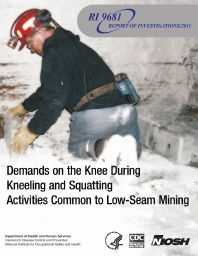Mining Publication: Demands on the Knee During Kneeling and Squatting Activities Common to Low-seam Mining
Original creation date: June 2011
In 2009, the operating height of approximately one fourth of underground coal mines in the U.S. restricted mine workers to kneeling, crawling, and/or stooping posture to perform work [MSHA 2009). The large number of knee injuries to these workers is likely attributed to exposure to musculoskeletal disorder risk factors (prolonged kneeling, crawling, and twisting on one's knees). Therefore, the National Institute for Occupational Safety and Health has investigated three different biomechanical parameters (muscle activity of the knee flexors and extensors, pressure at the knee, and the net forces and moments at the knee) as subjects assumed postures common to low-seam mining, both with and without kneepads. The postures evaluated included: (I) kneeling near full flexion; (2) kneeling near 90 degrees of knee flexion; (3) kneeling on one knee; and (4) squatting. The pressure and the net forces and moments at the knee were evaluated as subjects statically assumed these postures. However, negligible muscle activity existed for these static postures. Therefore, muscle activity of the knee flexors and extensors was evaluated for each posture while subjects performed a lateral lift that is common to low-seam mining where they lifted a 25-lb block from their right side, transferred it across their body, and placed it on the ground on their left side. The results indicated that, relative to the stresses posed by other kneeling postures, some postures had may have more detrimental effects than others. Considering the potential impact of the three biomechanical parameters, several key recommendations were made regarding when it may be most appropriate to use specific postures. Additional recommendations were also made regarding the design of kneepads.
Authors: SM Moore, JP Pollard, WL Porter, S Gallagher, AG Mayton
Report of Investigations - June 2011
NIOSHTIC2 Number: 20039248
Pittsburgh, PA: U. S. Department of Health and Human Services, Public Health Service, Centers for Disease Control and Prevention, National Institute for Occupational Safety and Health, DHHS (NIOSH) Publication No. 2011-176, RI 9681, 2011 Jun; :1-47
See Also
- Characteristics of Gait in Restricted Vertical Space Versus Unrestricted Walking
- Development and Evaluation of Prototype Kneepads for the Low-Seam Mining Industry
- Evaluation of Muscle Activity, Forces, Stresses, and Moments at the Knee During Kneeling and Squatting Tasks
- Forces and Moments on the Knee During Kneeling and Squatting
- Musculoskeletal Stress on Miners Performing Roof Screening Operations
- Physical Strength Assessment in Ergonomics
- Pressure Distribution on the Anatomic Landmarks of the Knee and the Effect of Kneepads
- Self-Reported Musculoskeletal Symptoms Among Operators of Heavy Construction Equipment
- Strength Testing
- Thigh-Calf and Heel-Gluteus Contact Forces in High Flexion: Experimental Results
- Content source: National Institute for Occupational Safety and Health, Mining Program


 ShareCompartir
ShareCompartir
